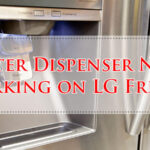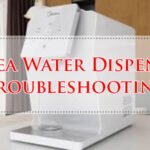A Kenmore 80 Series Washer not draining typically indicates a clogged drain hose or faulty pump. Checking and cleaning the hose or replacing the pump are common solutions.
Dealing with a Kenmore 80 Series Washer that refuses to drain can be frustrating for any homeowner. This issue can throw a wrench into your laundry routine, leaving you with a tub full of water and clothes that are far from clean.
Understanding the root cause is the first step towards a solution. Most often, the problem lies within the drain system itself, either due to blockages in the drain hose or issues with the pump. These components are crucial for the washer’s water evacuation process. Regular maintenance and timely checks can prevent such problems, ensuring your laundry day runs smoothly. Solving this issue not only restores the functionality of your washer but also extends its lifespan, saving you time and money in the long run.
Introduction To Kenmore 80 Series Washer Issues
The Kenmore 80 Series Washer is a household staple. It promises clean clothes with ease. Yet, even reliable machines face issues. A common problem is when it fails to drain. This can be frustrating. Let’s dive into the symptoms and solutions for this problem.
Common Symptoms
- Water remains after cycle ends
- Clothes are too wet post-wash
- Washer makes unusual noises
- Error codes appear on display
Importance Of Timely Solutions
Ignoring drainage issues can lead to bigger problems. Water damage and mold growth can occur. Quick fixes save time and money. They also extend the washer’s life. Let’s explore how to tackle these draining problems effectively.
Initial Checks Before Troubleshooting
Dealing with a Kenmore 80 Series washer that won’t drain can be frustrating. Before diving into more complex troubleshooting, perform some initial checks. These simple steps can often solve the issue quickly. They also help avoid unnecessary repairs.
Power Supply And Settings
Ensure your washer’s power cord is plugged in. Check for tripped circuit breakers or blown fuses. Reset or replace as needed. Press the power button on your washer. Confirm that the correct wash cycle is selected. Some settings prevent spin and drain cycles.
Hose Connections
Examine both the drain and inlet hoses at the back of your washer. Make sure they are secure and kink-free. Tighten any loose connections. Clear any visible blockages. Straighten hoses to allow free water flow. Check filters for debris and clean if necessary.
Inspecting The Drain Hose
When a Kenmore 80 Series Washer refuses to drain, a common culprit is the drain hose. A clogged or kinked hose disrupts water flow, preventing your washer from functioning properly. It’s essential to inspect the drain hose thoroughly. Here are steps to ensure it’s clear and functioning well.
Locating Clogs
Check the hose for any visible signs of obstruction. Twist and bends can trap debris or small clothing items, causing clogs. Ensure the washer is off and empty. Then, follow these simple steps:
- Disconnect the hose from the back of the washer.
- Look for kinks or twists that could block water flow.
- Use a flashlight to spot any blockages inside the hose.
Cleaning Steps
Cleaning the drain hose is straightforward. Gather basic tools like gloves and a bucket. Follow this guide:
- Prepare the area by placing a bucket under the hose.
- Remove the hose carefully to avoid spills.
- Flush the hose with water to clear out debris.
- If needed, use a plumber’s snake to remove tough clogs.
- Rinse the hose again to ensure it’s clean.
- Reattach the hose securely to the washer.
Regular maintenance prevents future clogs. Check and clean the hose periodically to keep your washer draining smoothly.

Credit: m.youtube.com
The Lid Switch Test
Is your Kenmore 80 Series Washer not draining? The culprit might be the lid switch. This safety feature stops the washer when the lid is open. A faulty switch means no draining. Let’s test and possibly replace it.
Functionality Check
Testing the lid switch is simple. Start with an empty washer. Set it to spin. Open and close the lid. You should hear a click. No click means the switch might be broken.
- Ensure the washer is off and unplugged.
- Open the washer’s lid.
- Locate the lid switch. It’s usually near the door frame.
- Press the switch manually. Listen for a click.
- No sound indicates a possible fault.
Replacement Tips
A broken lid switch needs replacing. Follow these tips for a smooth process:
- Unplug the washer. Safety first.
- Remove the washer’s cabinet to access the switch.
- Take a photo. Remember where wires go.
- Disconnect wires from the old switch.
- Remove the old switch. Note its position.
- Place the new switch in the same spot.
- Reconnect the wires as in the photo.
- Reassemble the washer cabinet.
- Plug in and test the washer.
With these steps, a new lid switch can be installed. Your washer should drain properly again.
Cleaning The Drain Pump Filter
Cleaning the Drain Pump Filter is crucial for Kenmore 80 Series Washer maintenance. A clogged filter can prevent your washer from draining properly. Regular cleaning ensures smooth operation. Follow this guide to locate and clean your washer’s drain pump filter.
Locating The Filter
The drain pump filter is typically at the washer’s front bottom. Access may vary by model. Consult your user manual for specifics. Unplug the washer and prepare a towel for any water spillage before starting.
Step-by-step Cleaning
- Prepare the area: Place towels on the floor. This catches water spills.
- Open the filter cover: Use the manual for guidance if needed.
- Drain remaining water: Some models have a small hose to drain water. If so, use it first.
- Remove the filter: Turn it counterclockwise and pull gently.
- Inspect the filter: Look for debris such as lint, coins, or small items.
- Clean the filter: Rinse under running water. Use a soft brush for stubborn grime.
- Check the cavity: Ensure no obstructions are inside the pump cavity.
- Replace the filter: Insert the clean filter. Turn clockwise until secure.
- Close the cover: Snap or screw the cover back into place.
Regular cleaning helps your Kenmore washer drain effectively. Perform these steps every few months or as needed.

Credit: www.ifixit.com
Checking The Drain Pump
When a Kenmore 80 Series Washer stops draining, the drain pump often needs attention. Checking this component can pinpoint the issue. A functioning pump is key for the washer’s performance. Let’s delve into the signs of a malfunctioning drain pump and how to tackle a DIY replacement.
Signs Of Malfunction
Several signs indicate a faulty drain pump in your Kenmore washer. Watch for these:
- Water remains in the drum after a cycle.
- Noises or vibrations during the drain cycle.
- Error codes appear on the washer’s display.
- Drain pump feels hot to the touch.
Diy Replacement Guide
Replacing the drain pump yourself can save time and money. Follow these steps:
- Unplug the washer.
- Access the pump’s location.
- Disconnect hoses and wiring.
- Remove the old pump.
- Install the new pump.
- Reconnect hoses and wiring.
- Test the washer.
Ensure the new pump is compatible with your Kenmore model. Perform these steps with care to avoid damage. If unsure, seek professional help.
Advanced Solutions
Dealing with a Kenmore 80 Series Washer that won’t drain can be frustrating. Sometimes, simple fixes won’t cut it. Here, we explore advanced solutions for when your washer refuses to cooperate. Let’s dive into professional help and what it might cost.
When To Call A Professional
If you’ve tried basic troubleshooting to no avail, it’s time to consider professional help. Here are signs you need an expert:
- Repeated issues with draining
- Strange noises during the cycle
- Water remains after multiple attempts
- Errors display on the washer’s panel
Don’t risk further damage to your machine or home. A certified technician can diagnose and fix the problem effectively.
Estimated Repair Costs
Repair costs can vary based on the issue and parts needed. Below is a breakdown of potential expenses:
| Service | Cost |
|---|---|
| Inspection Fee | $50 – $100 |
| Drain Pump Replacement | $150 – $400 |
| Unclogging Pipes | $100 – $200 |
| Electrical Repairs | $100 – $300 |
Prices are estimates and can change based on your location and washer model. Always get a quote before proceeding with repairs.
Preventative Maintenance Tips
Maintaining your Kenmore 80 Series Washer is key to performance. Regular care prevents draining issues. Follow these tips to keep your washer running smoothly.
Regular Cleaning Schedule
Keep your washer in top shape with routine cleans. Dirt build-up leads to clogs. A clean washer drains efficiently.
- Clean the lint filter after each use.
- Monthly, run an empty hot water cycle with vinegar.
- Wipe down the drum, agitator, and gaskets.
- Inspect and clean out the drain hose yearly.
Avoiding Common Mistakes
Some habits harm your washer. Avoid these to prevent drain problems.
| Mistake | Prevention Tip |
|---|---|
| Overloading | Load clothes loosely to the top row of holes. |
| Excess detergent | Use the right amount for your load size. |
| Ignoring small items | Check pockets before washing. |
| Forgetting maintenance | Schedule regular checks for your machine. |

Credit: www.amazon.com
Frequently Asked Questions
Why Is My Kenmore Washing Machine Not Draining Water?
Your Kenmore washing machine might not drain due to a clogged drain hose, faulty pump, or blocked filter. Check and clean these parts for a solution.
How To Manually Drain Kenmore 80 Series?
Unplug the washer and locate the lower front panel. Remove the screws, tilt the panel forward, and lift it off. Place a bucket under the drain pump’s access cap. Slowly unscrew the cap, allowing water to flow into the bucket.
Tighten the cap back once finished.
Why Is My Washing Machine Full Of Water And Not Draining?
Your washing machine might not drain due to a clogged drain hose or filter. Check these parts for blockages and clean them. A malfunctioning pump could also cause this issue, requiring professional inspection or replacement. Regular maintenance helps prevent such problems.
Why Is My Built In Washing Machine Not Draining?
A built-in washing machine might not drain due to a clogged filter, blocked drain hose, or malfunctioning pump. Check and clean the filter, ensure the hose is clear, and if issues persist, consult a professional for pump inspection or replacement.
Why Won’t My Kenmore 80 Series Washer Drain?
A Kenmore 80 Series Washer may not drain due to a clogged drain hose, faulty lid switch, or a blocked pump. Checking these components can often resolve the issue.
Conclusion
Troubleshooting a Kenmore 80 Series washer that won’t drain can be straightforward. Regular maintenance and prompt attention to issues prevent long-term damage. Remember to consult your manual or a professional when needed. For more tips and detailed guides, keep following our blog.
Your laundry routine deserves a smoothly running washer.





